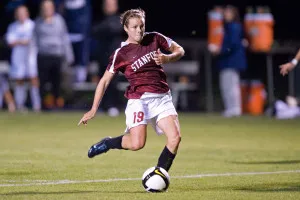Although its recent World Cup victory has turned the U.S. Women’s National Soccer Team into national celebrities, defender Kelley O’Hara ’10 has long been a star on the Stanford campus.

O’Hara and USWNT teammate Christen Press ’11 took the field at halftime of Stanford football’s game against UCLA on Thursday to raucous, familiar cheers from the appreciative student body.
O’Hara, a three-time All-American, was the first Stanford player to win the MAC Hermann Trophy for most outstanding player after a brilliant 2009 season in which she led the nation with 29 goals and 65 points. Though the 2006-2009 teams that O’Hara was a part of never won a national championship, they firmly established Stanford as a top program in the Pac-12 and across the nation.
Several top players on the Cardinal teams of the late 2000’s were recently named to the Pac-12’s All-Century Team, including head coach Paul Ratcliffe and fellow Hermann winners Press and Teresa Noyola ’12.
“It was very cool to be honored in that way,” O’Hara said of the all-century distinction. “It’s a testament to how good this program has been throughout its history.”
The common factor in Stanford’s decades-long success has been Ratcliffe’s consistent philosophy, based on intense defensive effort coupled with steady possession and an aggressive attacking mindset.
“I was really molded as a player by four years of Paul’s coaching,” O’Hara said. “Towards the end of my career, we started to get the players we needed to play his style, and the result was really beautiful soccer.”
O’Hara’s attacking mindset, instilled in her through years of playing in Ratcliffe’s relentless system, served her well in the World Cup semifinals against Germany. Though O’Hara plays a more defensive wingback position, her goal against a heavily-favored German team perfectly exhibited the high-motor and keen forward instincts that gave her so much success at Stanford.
Back in the U.S., Ratcliffe was watching nervously in his hotel room. When his TV started going out, he ran down to the lobby to keep up with the game. Fortunately, he was able to watch O’Hara’s goal in the 84th minute that cemented the USWNT’s appearance in the finals, in which the team would beat Japan to claim its first World Cup since 1999.
“It’s a little surreal to see everyone rally around us and so stoked on us winning, because for us it’s a dream come true,” O’Hara said. “It’s also a dream come true for a lot of fans out there, and it’s pretty cool to be a part of it.”
Despite her obligations to the national team and to her club team, Sky Blue FC of the National Women’s Soccer League, O’Hara frequently comes back to Stanford to support the Cardinal.
“[Kelley] is a legend in the game now after what she did at Stanford and recently in the World Cup,” Ratcliffe said. “It’s a great treat to meet with her and see how she’s doing and thank her for elevating Stanford women’s soccer into one of the premier teams in the country.”
O’Hara herself is sheepish about the role she provides for current members of the team, noting that, “I take any opportunity I can to come back here and pretend that I can hang with the kids.”
O’Hara’s humility belies exactly how important her success is to the future of Stanford women’s soccer and women’s soccer as a whole. Throughout the season, Stanford’s home games have been filled with young girls inspired by the technical skill and overall success of the Cardinal.
A few years ago, freshman forward Tegan McGrady was one of those girls. A San Jose native, McGrady would often come to Stanford soccer games for birthday parties or with her grandmother.
“I can still remember there was a huge tree where that piece of turf is,” McGrady recalls as she points to one of the side bleachers at Cagan Stadium. “Coming to Stanford games was a regular part of my life.”
After years of watching Stanford legends like O’Hara and Press, McGrady is now part of the second consecutive freshman class that was the top-rated recruiting class in the nation. Long after her collegiate career ended, O’Hara’s impact nationally has helped the Cardinal maintain their elite status.
“[O’Hara] came over to me in the first half [of Friday’s win against Colorado] and said, ‘Were you the one who scored that goal?’” McGrady said. “Little things like that can really inspire you.”
Though O’Hara’s past success has helped Stanford women’s soccer ensure a promising future, it remains to be seen whether the USWNT can replicate that on a national level.
Domestically, the NWSL continues to struggle, drawing an average of just 5,000 people to each game. As professional women’s leagues have started to emerge in Europe, America’s dominance over women’s soccer has dwindled. For both men and women, U.S. Soccer has historically not been able to translate the popularity and momentum of the World Cup into its domestic leagues.
However, the high-profile successes of O’Hara and other USWNT players may provide optimism for the sport’s continued popularity in the U.S. Months after the World Cup, it is not hard to spot young women sporting Carli Lloyd or Alex Morgan jerseys in the stands of Cagan Stadium.
“A lot of us get recognized a lot more, which is a little strange,” O’Hara noted. “But it’s good because it means that soccer’s growing, and people care. I think soccer in America is growing exponentially and it’s just going to keep getting bigger.”
Contact Sanjay Srinivas at sanjay_srinivas ‘at’ stanford.edu.
